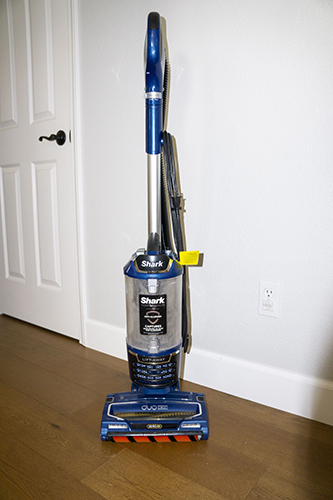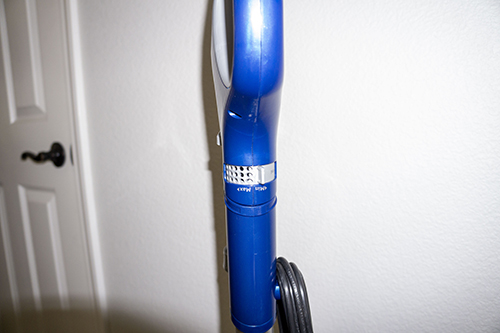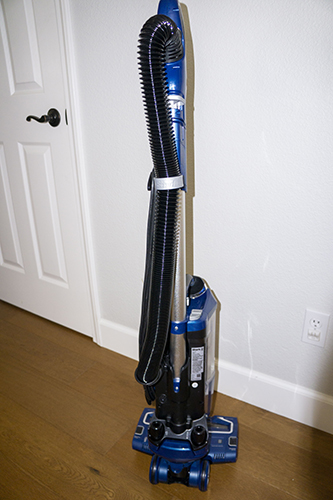Shark DuoClean with Zero-M Self-Cleaning Brushroll Lift-Away — upright vacuum cleaner — a review
© 2019 Peter Free
06 September 2019

Which Shark vacuum cleaner is being reviewed?
Shark, confusingly — given the baffling number of its closely related vacuum cleaners — avoids using its own model numbers to describe its products.
Shark's website refers to our model UV700 — the number which appears on the serial number sticker on our sample of the product — as a:
Shark DuoClean with Zero-M Self-Cleaning Brushroll Lift-Away upright vacuum cleaner
Some of the same terms appear on others among Shark's line of cleaners. For specificity, I will refer to the reviewed sample as model UV700.
As a spoiler, I'll note that Shark's casual sloppiness with respect to its lack of naming precision carries over into its engineering.
I find the UV700 more annoying than not to use.
The good
Suction is decent.
Bare floor setting works well. However, the carpet setting works better for low-rise pile, than for high-rise.
Emptying the vacuum is easy enough.
It is reasonably light in weight.
The Lift Away feature — which essentially permits one to make a small carry-vacuum out of the otherwise upright unit — works well enough to be useable.
In dim light, the UV700's front light is useful in highlighting dust that collects on bare floors along baseboards.
The not so good
Annoyances, in my estimation, outweigh the above positives.
Most irritating from my perspective, the UV700 dislikes tracking in straight lines.
It wanders right or left in unnecessarily erratic fashion. Correction takes just enough effort to become irritating over time. People with arthritic hands and wrists will not appreciate this.
I found the Shark's wandering tracking especially irritating, after having used an easily controlled Dyson Animal for many years. Indeed, I can think of no vacuum that I have come across, including in commercial use, that so consistently wanders off-track (like the Shark does) on both hard and soft floors.
Second, the cleaner's power cord is unnecessarily stiff and retains its U-to-U hook storage folds when in use on the floor. The cord also leaves the cleaner handle at a lower height, and projects from there more stiffly, than ideal.
That latter attribute seems to defy the cord handholding technique that I usually use to flop cleaner cords out of the vacuum's way.
Taken together, these two cord attributes mean that I often find the cord tangled around my feet. And/or the cleaner unable to pass completely over it, whether going forward or backward.
As a result, I often have to lift the whole unit off its cord and set it down somewhere else.
The Shark's inability to track consistently, without constant correction, contributes to the cleaner's tendency to partially ride over its own cord and get stuck on it. This irritation, by the way, occurs on both bare floors and carpet.
Overall, the cheap, stiff cord — which makes even removing and recoiling it a slight pain — is almost as much of an unnecessary nuisance as the vacuum's erratic tracking is.
Third, the vacuum's suction control dial is poorly located and works too easily. It consists of a plastic ring with a lever projection. The lever moves a holed (and not-holed) plastic ring from one side to the other in the cleaner's suction column. Suction is highest where there are no holes. And low, where there are many.

This suction-adjusting ring is located just under the cleaner's hand grip. Because of the suction adjuster's proximity to the grip — and its tendency to move under the slightest pressure — one easily changes suction without meaning to. This trait can result in undetectably uncleaned carpet.
Fourth — but much more minor — and compared to Dyson's old Animal — Shark's detachable hose works a little less efficiently. It takes a couple of steps to detach and re-attach it. The release button requires the user to bend over to push it. (It is the button at the top left of the cleaner base in the below photograph.)

And, after pulling the wand up and out of the cleaner's stem, one has to pull the hose's stem-securing ring out of a small hole in the cleaner's handle. (That is the gray-white ring around the black hose in the below photograph.)

This process seems slightly slower and requires more user movement than the Animal did. I preferred the Animal, primarily because I did not have to repetitively lean well over, each time I removed the wand. I also think that the Shark's hose retention ring is a stupidly implemented afterthought.
Seven month update (27 March 2020)
After using this cleaner for seven months, its low-exiting and inflexible cord still snares my legs on a regular basis.
And the vacuum still rolls over, and gets stuck on, the cord with a demon's determination.
The cleaner unit still falls over with even a mild sideways glace.
And as a result of its tendency to theatrically flop off the floor, the roller brush's plastic housing cover now pops erratically loose.
This looseness, in turn, results in the cleaner's headlight flashing (at speed) as a warning.
I had to look in the instruction book to see what the "shouting" light beam meant. One would think that a major electrical disaster was about to happen.
In reinstalling the roller brush, one can see why it is so lousy on taller pile carpets. By taller pile, I mean anything that is not almost flat, like an outdoor carpet. The roller is made of a plush-like velvet material.
This fabric manifests too much friction against significant amounts of pile. Furthermore, there is too little clearance between the roller itself and its housing. Even relatively small and unseen things get stuck in that narrowness and cause problems.
Overall, the brush and its housing are a poor design. Which, like much of modernity, the designers thought that it would be "cool" to design a flashing headlight function as warning. That laughably silly function apparently being intended to take the place of designing the mechanism correctly in the first place.
Last, releasing the debris canister from the cleaner is less than visually straightforward. You have to memorize which of several catches is the correct one to push.
Then, when you do find the right release, you have to hope that the bottom lid release on the canister — the one that holds collected debris back from spilling all over the floor — releases properly.
Today, ours did not. Not for the first time, either.
It waited until I had raised the canister toward stooping eye level to see what was wrong with it.
And naturally, I had the canister now away from the trash receptacle that I had been planning to dump its contents into. The latch only then "decided" let go. Naturally, an impressive volume of gray dust and bunnies sprayed all over the place.
All told
My impression is that Shark's engineers never used this unit for "serious" or constant work — before releasing their design as good enough.
It is not a bad vacuum, just a mildly (but constantly) irritating one.
The moral? — Not enthusiastically recommended
People who are not constantly annoyed by easily avoidable design flaws will probably like the Shark UV700. It gets the job done, under most circumstances.
I am among the probable minority of folk, who are irritated by stupid designs that taunt users on a continual basis.
Last — although I mentioned the Dyson Animal somewhat favorably — the newer Dysons that I see in stores are much more cheaply built than the Animal was. I am also not convinced they are even as mildly "good enough" as the Shark is. And, given Dyson's high prices, they are almost certainly not anywhere near as good a value as the Shark units are.
 PeteFree.com
PeteFree.com